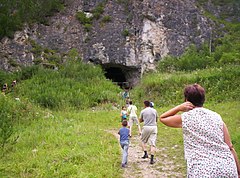Denisova Cave
| Денисова пещера | |

Denisova Cave
|
|
| Alternate name | Аю-Таш |
|---|---|
| Location | Altai Krai |
| Region | Siberia, Russia |
| Coordinates | 51°23′51.29″N 84°40′34.34″E / 51.3975806°N 84.6762056°ECoordinates: 51°23′51.29″N 84°40′34.34″E / 51.3975806°N 84.6762056°E |
| Type | limestone, karst |
| Area | 270 m2 (2,900 sq ft) |
| History | |
| Periods | Paleolithic 30,000 to 48,000 years ago |
| Cultures | Neanderthals |
Denisova Cave (Russian: Денисова пещера, Altai: Аю-Таш) is a cave in the Bashelaksky Range of the Altai mountains, Siberia, Russia. The cave is of great paleoarchaeological and paleontological interest. Bone fragments of the Denisova hominin, sometimes called the "X woman" (referring to the maternal descent of mitochondrial DNA) originate from the cave, including artifacts dated to around 40,000 BP.
The cave is located in a region thought to have been inhabited concurrently in the past by Neanderthals and modern humans. A bone needle dated to 50,000 years ago was discovered at the archaeological site in 2016 and is described as the most ancient needle known.
Located in Altai Krai, at the border of the Altai Republic, the cave is near the village of Chorny Anui (Чёрный Ануй), and some 150 km south of Barnaul, the nearest major city. The cave, which is approximately 28 m (92 ft) above the right bank of the Anuy River (a left tributary of the Ob), has formed in upper Silurian limestone and contains a floor area of about 270 m2 (2,900 sq ft). It contains a central chamber with a floor of 9 m (30 ft) x 11 m (36 ft) with side galleries. It has been described as both as a karst cave and as a sandstone cave.
Cave sediments are rich with remnants of animals, including extinct ones. Remains of 27 species of large and medium-sized mammals have been found, (such as cave hyena, cave lion, etc.) and 39 species of small mammals, as well as remnants of reptiles, 50 bird species and other vertebrates. Pollen in the sediments of cave is used for palaeoclimatological research.
...
Wikipedia


